
By Lana Sweeten-Shults
GCU News Bureau
There’s been much ado about common household spice turmeric in the world of Alzheimer’s disease research.
But is it much ado about nothing?
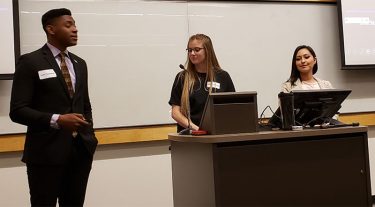
That’s what Marianna Estrella, Sean Thomason and Megan Anderson wanted to find out, and they spoke about their team’s work Saturday in the North Gym Lecture Halls as part of the second annual College of Science, Engineering and Technology Research Symposium and Honors College Showcase.
Buzz has surrounded the possibility of a substance called curcumin, found in turmeric, in treating Alzheimer’s disease. In lab studies, the bright yellow chemical has broken down the sticky amyloid-beta plaques that appear to gum up the brain in Alzheimer’s. So scientists have been researching curcumin, hoping it might be a viable treatment.
The problem: The chemical does not stick around in the body long enough to have a significant effect.
Enter Longvida, an over-the-counter curcumin supplement companies claim is more “bioavailable” and can survive the gastrointestinal tract -- a sort of curcumin 2.0, if you will.
“Given the fact that it’s a supplement, it had to have very little or no research to support that (claim),” Thomason said. “Our current study is attempting to put those claims under a microscope and examine whether Longvida or curcumin would be viable for fighting and attenuating the progression of Alzheimer’s in humans.”
After initial tests, the group concluded curcumin and any curcumin supplement needs more research, and the team plans to repeat the experiments.
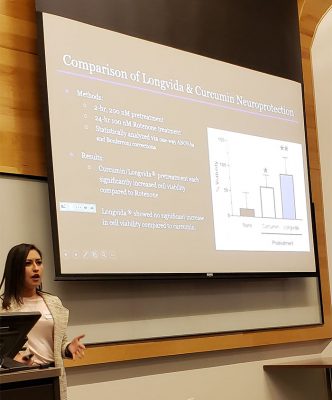
Estrella, Thomason and Anderson were just three of hundreds of students who presented their research in poster and oral presentations, split between Antelope Gymnasium and the North Gym Lecture Halls.
It was a massive convergence of research and projects that have been buzzing in labs and classrooms since the beginning of the year.
The research symposium and showcase is something Honors College Associate Dean Breanna Naegeli refused to miss.
“I’m technically still on maternity leave, but this is my absolute favorite event of the year,” Naegeli said. “It’s an exceptional opportunity to show what you’re doing outside of the classroom.”
Until 2017, CSET showcased student research during a poster session that was part of Health Sciences, Engineering and Technology Day, though the poster session's origins go back further. Drs. Galyna Kufryk and Brian Sillanpaa began the poster sessions in 2012. Since the Honors College also organized a showcase event with a similar structure that involved posters and oral presentations, Kufryk said it was logical to combine the CSET and Honors College events "so that the audience can get a feel for a broader scope of research that goes on at GCU."
For CSET, the symposium celebrates students’ work alongside their professors as part of the Research and Design Program. The symposium is organized similar to a scientific conference, in which research groups (students and their mentors) submit abstracts of their work. The best submitted abstracts are selected for oral presentations. Oral presenters receive certificates from CSET in recognition of their achievements, as do the authors of the best posters, who also receive certificates.
For the 2,000-student-strong Honors College, which featured projects by honors students of all majors, Naegeli said, it’s a “highly selective process” to be included in the annual end-of-year showcase. After submitting their work, students honed their talks in preliminary presentations for evaluation.

Junior pre-physical therapy major Payton Greer and fellow pre-PT major Kailan Pautz, a senior, spoke about their team’s look into the freshman 15 -- the infamous 15 pounds of weight freshmen supposedly gain in their first year of college -- in research titled “Impact of College Weight Gain on Body Fat Distribution.”
“As people enter college, their lifestyle completely transitions into being more sedentary,” Greer said. “… They actually gain about 1½ pounds per month.”
Subjects were asked to estimate their weight at ages 17 or 18, before college, and their weight from ages 19-21. They took the difference -- their weight gain -- and compared that to their waist circumference, which is significant because WHERE your body stores fat is more telling than overall weight. Waist circumference is considered an important marker in assessing one’s level of health risk.
Pautz said, in the study, “We can see how waist circumference is positively correlated with brachial blood pressure. As their waist circumference is increasing, so is their blood pressure, which makes them more prone to hypertension … that can indicate their path to a less healthy life.”
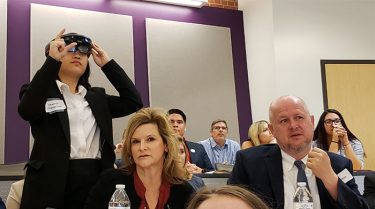
One team is working with the kind of technology movie-goers might be familiar with if they're fans of the Iron Man films, when Tony Stark projects computerized images and data mid-air and then manipulates that data with the touch of a finger.
"It's like that, except with a headset," said student researcher Brandon Neuheisel at an oral presentation of his team's research project, in which students are developing software to streamline what employees see at the PayPal Command Center using an augmented reality headset.
"The command centers are very large. Every single wall is covered in TV monitors, and every single monitor has data. ... Our goal is to condense that so they have a headset and only have the data they need," said Neuheisel, whose fellow presenters included Charinee Chantarasak, Brennan Robin, Rushabh Shah and Jamie Graham.
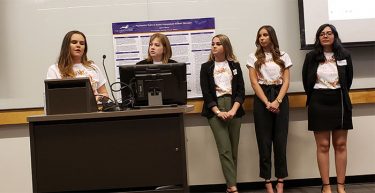
The team Girls Helping Girls presented its humanitarian project to a packed room.
“If you had to choose between eating dinner and maintaining your basic cleanliness, which would you choose?” asked Parker Hughes with fellow presenters Kaitlyn Johnson, Maria Zarate, Alyssa Smith and Kayci Mesko.
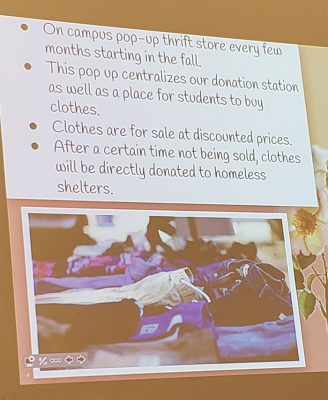
It’s something homeless women have to do often.
After visiting Phoenix Rescue Mission, the team discovered that federal and state funding is not provided for feminine products, so the group wants to create a way for GCU to start helping these women.
They want to create pop-up thrift stores that will serve as a donation station and a place for students to buy clothes at discounted prices (unsold clothes will be donated to homeless shelters). From donations, Girls Helping Girls will create basic hygiene kits for local shelters.
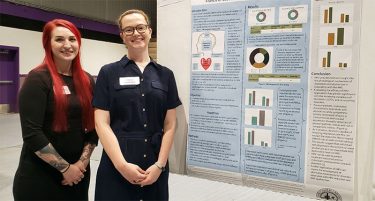
Francis Castellarin talked to symposium attendees about the research project “Implications of Alcohol Use and Depression on Heart Rate Variability.”
Heart rate is controlled by the autonomic nervous system, which regulates body functions and includes the parasympathetic and sympathetic nervous systems. In a healthy person, heart rate varies in a constant push and pull, “which is good,” Castellarin said.
But her team observed that the parasympathetic nervous system started to show dysfunction while the sympathetic system started to dominate in a person who was depressed or used alcohol and that “individuals with depression should limit or cease alcohol use.”
They explained how heart rate variability can be used to predict treatment outcomes. Also, HRV can inspire the development of alternative treatments for disorders associated with HRV reduction and dysfunction.
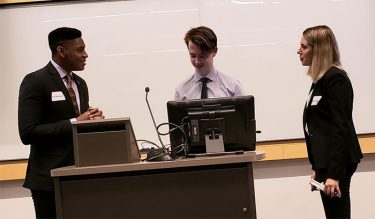
The 3Derma team returned to update its work on a hydrocolloidal bandage and gel for developing countries.
“Think back to a time when you got a cut and you were panicked,” said biomedical engineering junior Gabriela Calhoun, who guessed that most people in this country never panic about a cut.
It’s different in developing countries, such as in Nigeria, where a high percentage of infected wounds lead to amputations and even death.
“We wanted to change that,” said Calhoun, who presented with Sean Thomason and Ethan Nichols.
They developed a low-cost, 3D-printed bandage made of a gel-like, viscous substance that pulls in bacteria without letting it back out. The surface of the bandage is treated with essential oils to promote healing.
The team noted the progress made on the project, such as ascertaining the ideal mix of gel and essential oils for optimal healing and recovery.
The next step for the team is to start applying for funding, and it’s working on partnering with Project Cure.
After Saturday’s event, the Honors College will award scholarships to teams with the best presentations at the Honors Banquet on April 13.
And CSET judges already have identified the best posters:
-- In Microbiology, Cellular and Molecular Biology: “Efflux Pump Inhibitors as Antimicrobial Agents” (Halley McDonald, Daisy Savarirajan)
-- In Ecology, Organismal Biology and Exercise Physiology: “Desert Owl Population Improvement Project” (Destiny Woods, Madison Strong, Sarah Saffer, Ben Encinas); also, “Effect of Caffeine Use and Depression on Heart Rate Variability” (Brianna Reha, Chinenye Anako and Anju Dubey)
-- In Genetics: “Cystic Fibrosis” (Alexa Nolte, Galyna Kufryk); “Neurofibromatosis” (Austin Paschke, Anju Dubey)
-- In Engineering and Technology: “The Application of Hybrid Rocket Fuels to Low Cost Reusable Rocket Motors” (Daniel Hoven, Sean Fuller, Brenden Foster, Li Tan)
Biological sciences professor Dr. Galyna Kufryk, CSET symposium organizer, said the best part of this event for her is helping students take their work to a higher level: "For a researcher, especially a young researcher, there is no substitute for the personal interaction with other fellow researchers that fosters professional collaboration and research experience. Our symposium does just that."
Contact GCU senior writer Lana Sweeten-Shults at [email protected] or at 602-639-7901.
****
Related content:
GCU Today: “Hard work takes center stage at Honors symposium”
GCU Today: "HSET Day shows nuts and bolts of robots, sciences"
GCU Today: "Student research on display at symposium"















